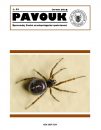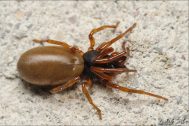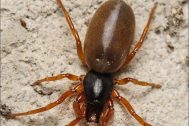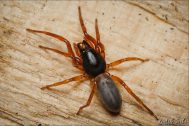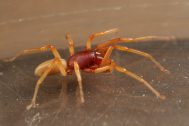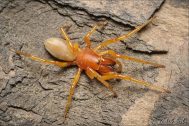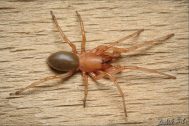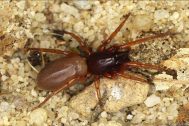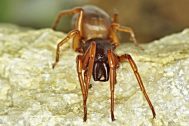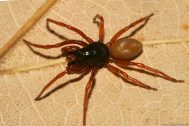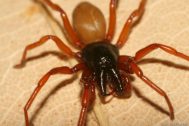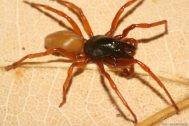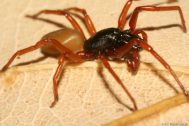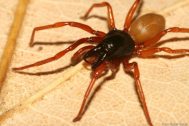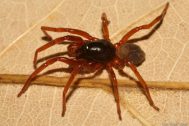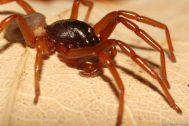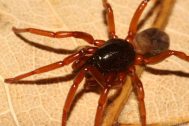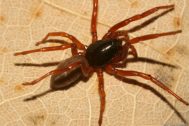| Records by time | |||||
|---|---|---|---|---|---|
| Dysderidae | 0-1900 | 1901-1950 | 1951-2000 | 2001+ | ∑ |
 Dysdera cechica
Řezáč, 2018 Not endangered Dysdera cechica
Řezáč, 2018 Not endangered |
1× | 1× | 31× | 74× | 107× |
 Dysdera crocata
C. L. Koch, 1838 Not endangered Dysdera crocata
C. L. Koch, 1838 Not endangered |
5× | 5× | |||
 Dysdera erythrina
(Walckenaer, 1802) Not endangered Dysdera erythrina
(Walckenaer, 1802) Not endangered |
16× | 6× | 137× | 92× | 251× |
 Dysdera hungarica
Kulczyński, 1897 Not endangered Dysdera hungarica
Kulczyński, 1897 Not endangered |
4× | 17× | 21× | ||
 Dysdera moravica
Řezáč, 2014 Almost threatened Dysdera moravica
Řezáč, 2014 Almost threatened |
27× | 9× | 36× | ||
 Dysdera ninnii
Canestrini, 1868 Dysdera ninnii
Canestrini, 1868 |
1× | 1× | |||
Bibliography
Pavouci a sekáči (Arachnida: Araneae, Opiliones) Klánovického lesa a jeho okolí v Praze.
The studied locality, i.e. Klánovický les Forest is situated on the edge of Prague, one of the most polluted areas in the Czech Republic. Thanks to large area the forest acts as an isolation from agrochemicals, thus allowing the existence of some habitats sensitive to eutrophisation, in particular peat-bogs, heaths, bare sandy soils, and Molinia meadows. The habitats harbour unusually high species diversity of spiders and harvestmen: the author recorded 286 spider and 11 harvestman species there, which is approximately one third of the Czech fauna. Sixty one of them are red-listed in the Czech Republic. Peat-bog linyphiid Saaristoa abnormis, and steppe lycosid Alopecosa schmidti and linyphiid Panamomops inconspicuus are listed as endangered. Local small peat-bogs offer suitable conditions for disappearing lycosids Hygrolycosa rubrofasciata, Pirata piscatorius and Piratula uliginosa, while heaths harbour the disappearing Oxyopes ramosus. Water spider Argyroneta aquatica has recently been found in small pools in ditches along the railway. Littoral vegetation is inhabited by Theridiosoma gemmosum and the jumping spider Calositticus floricola. Disturbed soil surface of wet meadows harbours the wolf spider Arctosa leopardus. Some species have recently appeared at the site, for example Dysdera hungarica, the harvestman Nemastoma bidentatum sparsum or the crab spider Synema globosum. The first two were probably introduced there by man, the latter probably expands due to climate change. The author suggests to keep these habitats without woody vegetation to protect local high species diversity there.Pavouk 44 (6/2018)
Pavouci České republiky; Druhy rodu Dysdera (Dysderidae) v Česku; Pholcus alticeps na severozápadě České republiky; Díky osobnímu automobilu; Výprava za stepníky a teplomilnými křižáky na jižní Moravu; Významné nálezy pavouků z ČR IV. / Remarkable records of spiders from Czechia IV.; Inventarizace 2017; Hrabalky (Pompilidae) – specialisté na lov pavouků II: rod Cryptocheilus; Jak dlouho vydrží Dolomedes pod vodou?; Rozloučení se Zdeňkem; Říkali jsme mu „haldový expert“; Zoologické dny Praha 2018; Arachnologická exkurze Litovelské Pomoraví; Česká bibliografie 2018; Britská bibliografie – The Newsletter 140 a 141; Pokyny pro autoryTaxonomic revision and insights into the speciation mode of the spider Dysdera erythrina species complex (Araneae: Dysderidae): sibling species with sympatric distributions.
The genus Dysdera Latreille, 1804, a species-rich group of spiders that includes specialised predators of woodlice, contains several complexes of morphologically similar sibling species. Here we investigate species limits in the Dysdera erythrina (Walckenaer, 1802) complex by integrating phenotypic, cytogenetic and molecular data, and use this information to gain further knowledge on its origin and evolution. We describe 16 new species and redescribe four poorly known species belonging to this clade. The distribution of most of the species in the complex is limited to southern France and the north-eastern Iberian Peninsula. The species studied do not show any obvious differences in habitat preference, and some of them even occur sympatrically at certain sites. They probably feed on the same type of prey as they readily capture woodlice. On the other hand, they differ in body size, mouthparts shape, sculpturing of carapace, morphology of the copulatory organs, karyotype and DNA sequences. Experimental interspecific mating showed a partial precopulatory behavioural barrier between Dysdera erythrina and Dysdera cechica, sp. nov. Our data suggest that karyotype evolution of the complex included chromosome fusions and fissions as well as translocations (between autosomes as well as autosomes and sex chromosomes). We hypothesise that chromosome rearrangements generating reproductive incompatibility played a primary role in speciation within Dysdera complexes. Dysdera spiders are poor dispersers, and their original distribution areas (forested areas in the Mediterranean) were repeatedly fragmented during Quarternary climatic oscillations, facilitating integration of chromosome rearrangements into karyotypes by genetic drift. Sympatric occurrence of closely related species may have been promoted by prey segregation as suggested by differentiation in body size in co-occurring species. The following new species are described: D. catalonica, sp. nov., Dysdera cechica, D. dolanskyi, sp. nov., D. fabrorum, sp. nov., D. garrafensis, sp. nov., D. graia, sp. nov., D. kropfi, sp. nov., D. minairo, sp. nov., D. portsensis, sp. nov., D. pradesensis, sp. nov., D. pyrenaica, sp. nov., D. quindecima, sp. nov., D. septima, sp. nov., D. stahlavskyi, sp. nov., D. tredecima, sp. nov. and D. undecima, sp. nov.
Pavouk 38 (7/2015)
Méně známé druhy pavouků – Frontinellina frutetorum; Pirata von Noldenteich; Křižák Neoscona adianta za humny!; Ještě Porrhomma; Jak je to s původem křižáka Argiope bruennichi v Česku?; Rytířský souboj; Arachnologická exkurze – jižní Morava 2015; Ocenění arachnologové; Aktualizace rolí v České arachnologické společnosti; Konference; Česká bibliografie; Britská bibliografie; Inventarizace 2014The spider genus Dysdera (Araneae, Dysderidae) in central Europe: revision and natural history
Nine species of the genus Dysdera were found to occur in central Europe: D. adriatica Kulczyński 1897, Dysdera crocata Koch 1838, D. dubrovninnii Deeleman-Reinhold 1988, Dysdera erythrina (Walckenaer 1802), Dysdera ninnii Canestrini 1868, Dysdera hungarica Kulczyński 1897, D. lantosquensis Simon 1882, D. longirostris Doblika 1853, and D. taurica Charitonov 1956. Two species, D. dubrovninnii and D. lantosquensis, are newly recorded from central Europe. The original description of D. hombergi (Scopoli 1763), the name used for a common species of the genus Harpactea, probably refers to Dysdera ninnii. We retain the name Dysdera ninnii as a nomen protectum. Dysdera hamulata Kulczyński 1897 appears to be a junior synonym of D. maurusia Thorell 1873. This North African species probably does not occur in central Europe, and a previous record from Slovakia is probably based on mislabeled material. A review of all species of Dysdera named from outside the Palearctic region demonstrated that D. australiensis Rainbow 1900 and D. magna Keyserling 1877 are junior synonyms of Dysdera crocata, and that D. bicolor Tatzanovski 1874 and D. solers Walckenaer 1837 are erroneously placed in the genus Dysdera; the former is likely to be an oonopid and the latter a caponiid. In central Europe, Dysdera spiders prefer xerothermic forests, particularly sites enriched by calcium. All species probably have biennal life-cycles. The karyotype of males of seven species were examined, and diploid chromosome numbers were found to be extraordinarily variable, ranging from 9 (Dysdera crocata) to 40 (D. longirostris). Karyotypes consist of holocentric chromosomes.Evidence for woodlice-specialization in Dysdera spiders: behavioural versus developmental approaches.
The dietary specialization in a woodlouse-eating spider Dysdera hungarica Kulczyñski (Araneae: Dysderidae) is studied using two types of laboratory experiments. In the first experiment, the rate of development of spiderlings reared on one of three diets: pure woodlice [composed of two species Oniscus asellus Linnaeus and Armadillidium vulgare (Latreille)], pure flies (Drosophila melanogaster Meigen), and a mixed woodlouse-fly diet, is studied. Spiders develop significantly faster on the woodlice-containing diets (i.e. pure woodlice and mixed diet) than on the fly diet. In the second experiment, the prey-choice for two woodlice species (O. asellus and A. vulgare) and a fly (D. melanogaster) is investigated. Dysdera hungarica spiders capture significantly more often flies than woodlice. These contrasting results reveal the different value of developmental and behavioural experiments. The dietary studies are assumed to provide better evidence of specialization than behavioural experiments, which might be misleading due to unnatural conditions. It is concluded that Dysdera hungarica is a metabolically adapted woodlice specialist. The present study thus provides the first evidence of nutritional specialization on woodlice.
Gallery
Dysdera cechica
Dysdera crocata
Dysdera erythrina
Dysdera hungarica
Dysdera moravica
Statistics
By month
By altitude
By collecting method (420 used records)
| Zemní past | Males | Females | Juveniles | Records |
|---|---|---|---|---|
| Dysdera cechica Řezáč, 2018 | 53 | 56 | 27 | 67 |
| Dysdera erythrina (Walckenaer, 1802) | 82 | 105 | 4 | 117 |
| Dysdera hungarica Kulczyński, 1897 | 0 | 45 | 0 | 9 |
| Dysdera moravica Řezáč, 2014 | 9 | 11 | 0 | 16 |
| Dysdera ninnii Canestrini, 1868 | 0 | 1 | 0 | 1 |
| Neurčeno | Males | Females | Juveniles | Records |
| Dysdera cechica Řezáč, 2018 | 13 | 19 | 0 | 26 |
| Dysdera crocata C. L. Koch, 1838 | 0 | 1 | 0 | 1 |
| Dysdera erythrina (Walckenaer, 1802) | 12 | 9 | 0 | 90 |
| Dysdera hungarica Kulczyński, 1897 | 0 | 4 | 0 | 7 |
| Dysdera moravica Řezáč, 2014 | 0 | 8 | 0 | 14 |
| Individuální sběr | Males | Females | Juveniles | Records |
| Dysdera cechica Řezáč, 2018 | 6 | 6 | 0 | 10 |
| Dysdera crocata C. L. Koch, 1838 | 1 | 1 | 1 | 2 |
| Dysdera erythrina (Walckenaer, 1802) | 8 | 22 | 4 | 31 |
| Dysdera hungarica Kulczyński, 1897 | 0 | 4 | 0 | 4 |
| Dysdera moravica Řezáč, 2014 | 0 | 5 | 0 | 5 |
| Prosev | Males | Females | Juveniles | Records |
| Dysdera cechica Řezáč, 2018 | 1 | 2 | 0 | 2 |
| Dysdera erythrina (Walckenaer, 1802) | 3 | 4 | 0 | 8 |
| Dysdera moravica Řezáč, 2014 | 1 | 0 | 0 | 1 |
| Smyk | Males | Females | Juveniles | Records |
| Dysdera cechica Řezáč, 2018 | 2 | 0 | 0 | 2 |
| Dysdera erythrina (Walckenaer, 1802) | 1 | 1 | 2 | 5 |
| Fotografie | Males | Females | Juveniles | Records |
| Dysdera crocata C. L. Koch, 1838 | 0 | 0 | 0 | 1 |
| Podzemní trubkové pasti | Males | Females | Juveniles | Records |
| Dysdera hungarica Kulczyński, 1897 | 0 | 14 | 0 | 1 |
| Males | Females | Juveniles | Records |
By biotope (408 used records)
| Neurčeno | Males | Females | Juveniles | Records |
|---|---|---|---|---|
| Dysdera cechica Řezáč, 2018 | 26 | 52 | 21 | 55 |
| Dysdera erythrina (Walckenaer, 1802) | 19 | 14 | 7 | 114 |
| Dysdera hungarica Kulczyński, 1897 | 0 | 9 | 0 | 10 |
| Dysdera moravica Řezáč, 2014 | 1 | 9 | 0 | 16 |
| Dysdera ninnii Canestrini, 1868 | 0 | 1 | 0 | 1 |
| Suché louky | Males | Females | Juveniles | Records |
| Dysdera cechica Řezáč, 2018 | 7 | 2 | 6 | 7 |
| Dysdera erythrina (Walckenaer, 1802) | 7 | 31 | 0 | 18 |
| Dysdera hungarica Kulczyński, 1897 | 0 | 14 | 0 | 1 |
| Dysdera moravica Řezáč, 2014 | 1 | 1 | 0 | 2 |
| Nehluboké podzemní prostory (pukliny, půdní horizonty) | Males | Females | Juveniles | Records |
| Dysdera cechica Řezáč, 2018 | 3 | 1 | 0 | 1 |
| Dysdera erythrina (Walckenaer, 1802) | 8 | 39 | 0 | 22 |
| Dysdera hungarica Kulczyński, 1897 | 0 | 31 | 0 | 2 |
| Lesostepní doubravy | Males | Females | Juveniles | Records |
| Dysdera cechica Řezáč, 2018 | 4 | 0 | 0 | 2 |
| Dysdera erythrina (Walckenaer, 1802) | 12 | 8 | 0 | 17 |
| Dysdera hungarica Kulczyński, 1897 | 0 | 1 | 0 | 1 |
| Dysdera moravica Řezáč, 2014 | 1 | 0 | 0 | 1 |
| Suché doubravy | Males | Females | Juveniles | Records |
| Dysdera cechica Řezáč, 2018 | 8 | 9 | 0 | 9 |
| Dysdera erythrina (Walckenaer, 1802) | 15 | 1 | 2 | 4 |
| Dysdera moravica Řezáč, 2014 | 2 | 1 | 0 | 3 |
| Kamenité suti nižších poloh | Males | Females | Juveniles | Records |
| Dysdera cechica Řezáč, 2018 | 0 | 0 | 0 | 1 |
| Dysdera erythrina (Walckenaer, 1802) | 3 | 2 | 0 | 5 |
| Dysdera moravica Řezáč, 2014 | 2 | 6 | 0 | 4 |
| Suťové a roklinové lesy | Males | Females | Juveniles | Records |
| Dysdera cechica Řezáč, 2018 | 4 | 1 | 0 | 3 |
| Dysdera erythrina (Walckenaer, 1802) | 6 | 4 | 0 | 7 |
| Skalní stepi na vápenci | Males | Females | Juveniles | Records |
| Dysdera erythrina (Walckenaer, 1802) | 4 | 6 | 0 | 8 |
| Dysdera hungarica Kulczyński, 1897 | 0 | 1 | 0 | 1 |
| Dubohabřiny | Males | Females | Juveniles | Records |
| Dysdera cechica Řezáč, 2018 | 8 | 6 | 0 | 6 |
| Dysdera erythrina (Walckenaer, 1802) | 0 | 3 | 0 | 3 |
| Přirozené lesy | Males | Females | Juveniles | Records |
| Dysdera erythrina (Walckenaer, 1802) | 0 | 2 | 0 | 2 |
| Dysdera moravica Řezáč, 2014 | 3 | 4 | 0 | 7 |
| Ovocné sady s luční vegetací | Males | Females | Juveniles | Records |
| Dysdera cechica Řezáč, 2018 | 6 | 4 | 0 | 6 |
| Dysdera erythrina (Walckenaer, 1802) | 0 | 2 | 0 | 1 |
| Výsadby jehličnanů | Males | Females | Juveniles | Records |
| Dysdera erythrina (Walckenaer, 1802) | 3 | 4 | 0 | 7 |
| Kamenolomy | Males | Females | Juveniles | Records |
| Dysdera cechica Řezáč, 2018 | 1 | 2 | 0 | 3 |
| Dysdera erythrina (Walckenaer, 1802) | 2 | 1 | 0 | 2 |
| Suché křoviny | Males | Females | Juveniles | Records |
| Dysdera cechica Řezáč, 2018 | 3 | 1 | 0 | 3 |
| Dysdera erythrina (Walckenaer, 1802) | 2 | 0 | 0 | 2 |
| Lesy | Males | Females | Juveniles | Records |
| Dysdera cechica Řezáč, 2018 | 0 | 0 | 0 | 2 |
| Dysdera erythrina (Walckenaer, 1802) | 5 | 2 | 0 | 2 |
| Bučiny nižších poloh | Males | Females | Juveniles | Records |
| Dysdera erythrina (Walckenaer, 1802) | 4 | 1 | 0 | 4 |
| Lesy | Males | Females | Juveniles | Records |
| Dysdera cechica Řezáč, 2018 | 0 | 1 | 0 | 1 |
| Dysdera erythrina (Walckenaer, 1802) | 2 | 0 | 0 | 2 |
| Stinné skály nižších poloh | Males | Females | Juveniles | Records |
| Dysdera moravica Řezáč, 2014 | 0 | 3 | 0 | 3 |
| Interiéry budov | Males | Females | Juveniles | Records |
| Dysdera cechica Řezáč, 2018 | 0 | 1 | 0 | 1 |
| Dysdera crocata C. L. Koch, 1838 | 1 | 1 | 1 | 2 |
| Suché lesní lemy | Males | Females | Juveniles | Records |
| Dysdera erythrina (Walckenaer, 1802) | 2 | 1 | 0 | 3 |
| Haldy a výsypky | Males | Females | Juveniles | Records |
| Dysdera cechica Řezáč, 2018 | 0 | 1 | 0 | 1 |
| Dysdera erythrina (Walckenaer, 1802) | 2 | 1 | 0 | 2 |
| Reliktní bory na skalách | Males | Females | Juveniles | Records |
| Dysdera erythrina (Walckenaer, 1802) | 2 | 1 | 0 | 3 |
| Xerotermní travinobylinná společenstva | Males | Females | Juveniles | Records |
| Dysdera erythrina (Walckenaer, 1802) | 0 | 2 | 0 | 2 |
| Travnaté stepi | Males | Females | Juveniles | Records |
| Dysdera erythrina (Walckenaer, 1802) | 0 | 1 | 0 | 1 |
| Dysdera hungarica Kulczyński, 1897 | 0 | 1 | 0 | 1 |
| Jeskyně | Males | Females | Juveniles | Records |
| Dysdera erythrina (Walckenaer, 1802) | 0 | 5 | 0 | 2 |
| Lesní okraje | Males | Females | Juveniles | Records |
| Dysdera cechica Řezáč, 2018 | 1 | 0 | 0 | 1 |
| Dysdera erythrina (Walckenaer, 1802) | 1 | 1 | 0 | 1 |
| Horské bučiny | Males | Females | Juveniles | Records |
| Dysdera erythrina (Walckenaer, 1802) | 1 | 1 | 0 | 2 |
| Stepi, vřesoviště, písčiny | Males | Females | Juveniles | Records |
| Dysdera erythrina (Walckenaer, 1802) | 0 | 1 | 0 | 1 |
| Ruderály | Males | Females | Juveniles | Records |
| Dysdera erythrina (Walckenaer, 1802) | 0 | 1 | 0 | 1 |
| Acidofilní bory | Males | Females | Juveniles | Records |
| Dysdera cechica Řezáč, 2018 | 1 | 0 | 0 | 1 |
| Slaniska | Males | Females | Juveniles | Records |
| Dysdera hungarica Kulczyński, 1897 | 0 | 3 | 0 | 1 |
| Porosty borůvek | Males | Females | Juveniles | Records |
| Dysdera cechica Řezáč, 2018 | 2 | 0 | 0 | 1 |
| Louky | Males | Females | Juveniles | Records |
| Dysdera cechica Řezáč, 2018 | 0 | 0 | 0 | 1 |
| Okraje silnic | Males | Females | Juveniles | Records |
| Dysdera crocata C. L. Koch, 1838 | 0 | 0 | 0 | 1 |
| Mokřady | Males | Females | Juveniles | Records |
| Dysdera cechica Řezáč, 2018 | 1 | 0 | 0 | 1 |
| Výsadby listnáčů | Males | Females | Juveniles | Records |
| Dysdera erythrina (Walckenaer, 1802) | 2 | 2 | 0 | 1 |
| Paseky | Males | Females | Juveniles | Records |
| Dysdera cechica Řezáč, 2018 | 0 | 2 | 0 | 1 |
| Těžebny písku a jiných nezpevněných hornin | Males | Females | Juveniles | Records |
| Dysdera hungarica Kulczyński, 1897 | 0 | 4 | 0 | 1 |
| Skalní stepi na jiných horninách | Males | Females | Juveniles | Records |
| Dysdera erythrina (Walckenaer, 1802) | 1 | 1 | 0 | 1 |
| Obhospodařované pozemky | Males | Females | Juveniles | Records |
| Dysdera hungarica Kulczyński, 1897 | 0 | 1 | 0 | 1 |
| Polní biotopy | Males | Females | Juveniles | Records |
| Dysdera hungarica Kulczyński, 1897 | 0 | 1 | 0 | 1 |
| Vnější stěny budov | Males | Females | Juveniles | Records |
| Dysdera crocata C. L. Koch, 1838 | 0 | 1 | 0 | 1 |
| Males | Females | Juveniles | Records |

